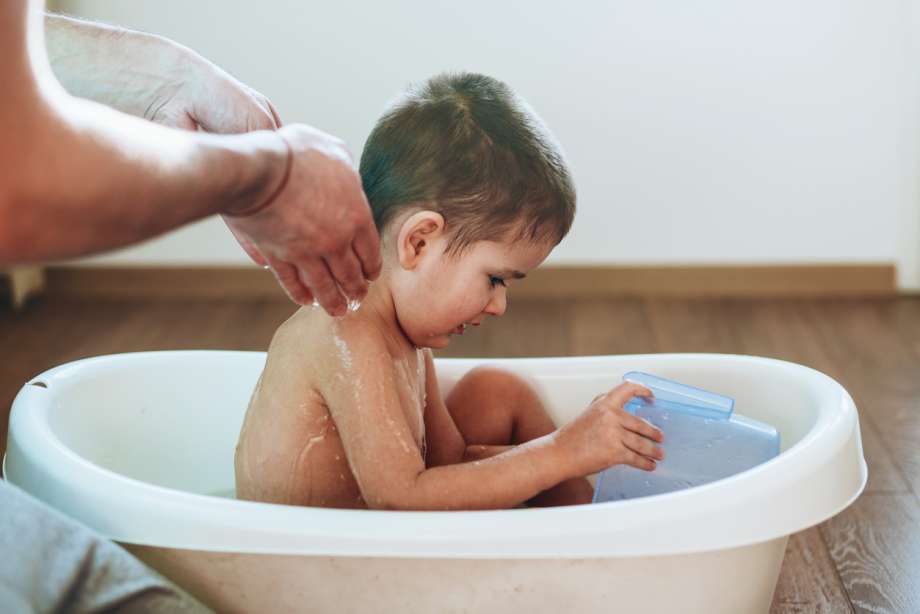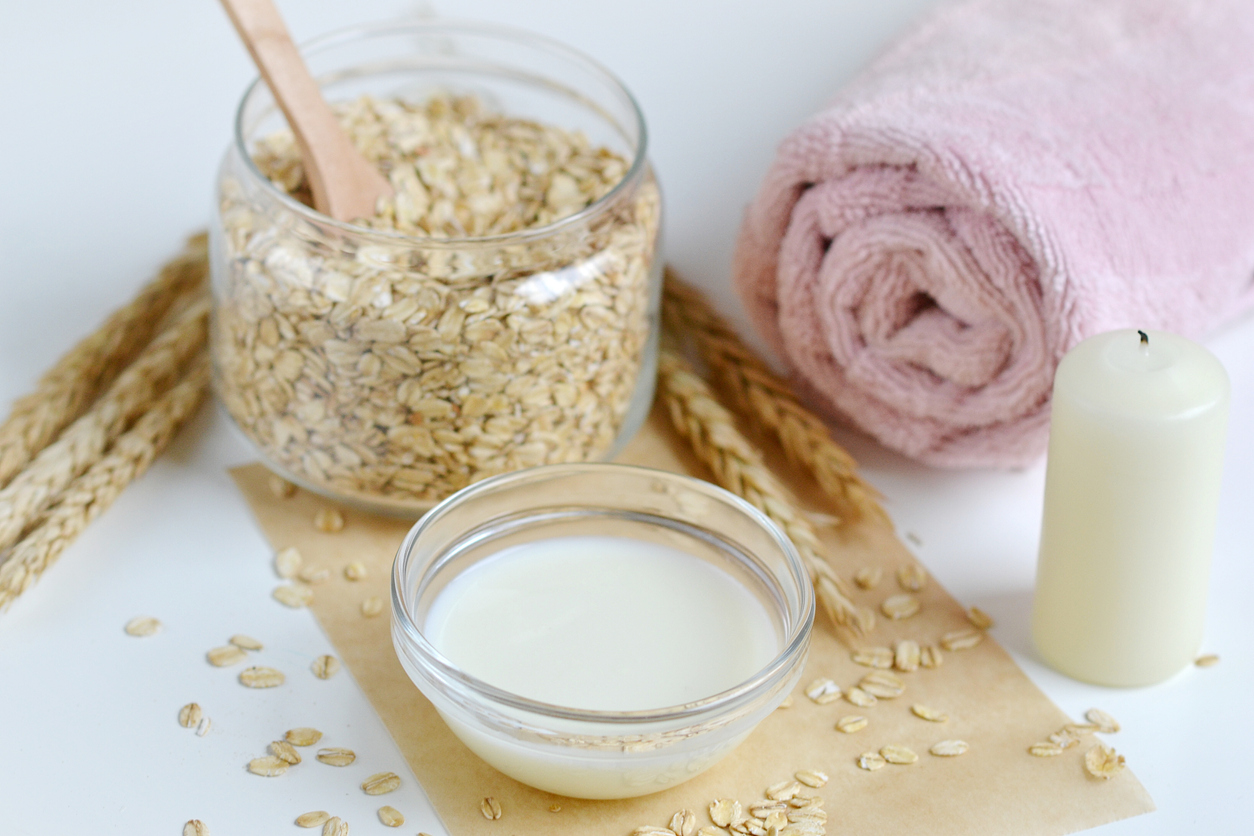Do Oatmeal Baths Really Work for Eczema and Itchy Skin?

Many people claim that oatmeal baths are a great home remedy to soothe a child’s chickenpox, eczema, sunburn, dermatitis and other skin conditions. But what is the science behind it? Do they really work?
Yes! This is no old-wives tale. There is evidence-based research that oatmeal baths can be helpful for different skin problems including eczema, chicken pox and other skin irritation issues.
Learn how to make an oatmeal bath for you or your child in order to soothe their painful or irritated skin.
Related: Dealing with Dermatitis in Young Children
History and safety of oatmeal for skin treatments
According to an article published by the Journal of Drugs in Dermatology, colloidal oatmeal formulations in the treatment of atopic dermatitis have been available since 1945.
Then several decades after, the Food and Drug Administration (FDA) recognized colloidal oatmeal as a safe and effective Category I ingredient in 1989. It was approved as a skin protectant in 2003.
Nowadays, you can see colloidal oatmeal in various products such as bath soaps, face masks, scrubs, cleansers, creams, moisturizers, shampoos and shaving gels. Colloidal oatmeal refers to an oatmeal suspension that is created by finely grinding oatmeal and suspending it in a liquid.
Colloidal oatmeal is very safe to use. A study tested the safety and efficacy of personal care products containing colloidal oatmeal. Personal care products including creams, cleansers and lotions were tested for irritant and allergenic potential.
They used repeat insult patch testing, in safety-in-use and ocular studies with subjects who had normal and sensitive skin. The study also assessed dry skin care products for their skin repair and moisturizing properties.
The results showed that personal care products with colloidal oatmeal had a very low irritant and allergenic potential.
During the patch testing, 1.0% of the subjects had a low-level reaction. Subjects with dry skin had improvements in their condition and the effect continued 2 weeks after they stopped using the product. The researchers concluded that colloidal oatmeal in personal care products is safe and effective.
What are the benefits of an oatmeal bath for your skin?
The main benefit of colloidal oatmeal is that it helps ease dry and itchy skin. When oatmeal is ground up into a fine consistency, they hold water better and it becomes an emollient that helps soften and soothe the skin.

One of the reasons why oatmeal baths are a safe, simple and effective way to treat skin conditions is because colloidal oatmeal is anti-inflammatory. Its anti-inflammatory properties are due to the antioxidants that are contained in oatmeal. Specifically, these include aventhramides, vitamin E and ferulic acid.
In 2015, a blind study that looked at the exact mechanism of action for the anti-inflammatory activity of colloidal oatmeal was published in the Journal of Drugs in Dermatology. It involved healthy female participants who had mild to moderate itchy, dry skin in their lower legs. The subjects were provided colloidal oatmeal skin protectant lotions.
The results of the study showed that colloidal oatmeal:
- Reduced pro-inflammatory cytokines in vitro.
- Improved skin dryness, itchiness, scaling, and roughness
- Treated dry and irritated skin through anti-oxidant and anti-inflammatory activities
Colloidal oatmeal can also be beneficial for those with eczema. A double-blind study investigated the efficacy of colloidal oatmeal cream 1% as an add-on therapy in the management of chronic irritant hand eczema. They included patients who were diagnosed with hand eczema and randomly assigned them to either the intervention or control group.
Both groups were given fluocinolone ointment for the first 2 weeks of treatment. The intervention was asked to use a colloidal oatmeal 1% cream and the control group used a base cream.
The study concluded that colloidal oatmeal can effectively reduce eczema severity symptoms due to its barrier protection, anti-inflammatory, moisturization and soothing properties.
In addition to eczema and dry, itchy skin, other conditions that people use colloidal oatmeal for include the following:
- Chickenpox
- Diaper rash
- Psoriasis
- Insect bites
- Reactions and rash to poison ivy, oak, sumac
- Shingles
- Sunburn
How do you make an oatmeal bath?
Before giving your child an oatmeal bath to ease their skin condition, it’s important to ask your doctor or pediatrician if there are any risks specific to your child. Although the FDA has deemed oatmeal baths as safe, your child may still have an allergic reaction to oatmeal.

If your child has not shown any signs of an allergy to colloidal oatmeal containing personal care products, it is most likely safe for them to take an oatmeal bath.
If you’re worried about a potential allergic reaction, you can do a “patch test” before the oatmeal bath. Apply a small amount of oatmeal suspension on the back of your child’s hand or the inside of their forearm.
Wait for about 15 minutes and then wash the oatmeal off. Take a close look at their skin to see if there is any redness, swelling or itchiness.
Once you are certain it is safe for your child, you can begin the steps in preparing a skin-soothing oatmeal bath. It is inexpensive, simple and effective in helping them with their skin condition.
What you need to make an oatmeal bath:
- Equipment to grind the oats such as a blender, spice or coffee grinder or food processor
- 1 cup of plain oatmeal (These can be instant oats, quick-cooking or slow-cooking. Make sure they do not have flavoring, coloring, salt, sugar or other additives or preservatives)
- Warm water
- A bag to hold the oatmeal (optional). This could be pantyhose, a cotton drawstring bag or cheesecloth.
Steps to prepare an oatmeal bath
- 1 Add the oats into your grinder of choice and blend them at the highest level. They should have the consistency of a very fine powder that can easily dissolve in hot water.
- Turn on the water for your bath. Make sure the water isn’t too hot. It is best to use lukewarm (not hot) water to combat dry skin and minimize flare-ups.
- Add the oatmeal powder to the bath and use your hand to mix it evenly in the water. Make sure the powder dissolves completely. Check for clumps on the bottom of the tub with your hand.
- Optional: Some people prefer to use a bag such as a tied-up cheesecloth or pantyhose to hold the oatmeal. This can help minimize tub cleaning after the bath.
- Help your child into the bath, making sure they don’t fall or trip over the ledge. Allow your child to submerge their body into the water and soak in the soothing properties of the oatmeal. With infants, it's important to hold onto them carefully. The oatmeal bath water can be extra slippery.
- According to the National Eczema Association, it is recommended that baths be limited to 10 to 15 minutes to prevent the skin from losing moisture content and causing irritation.
- Don’t scrub their skin with a washcloth or loofah as it can exacerbate their condition.
- There is no need to rinse after an oatmeal bath. Help your child out of the bath and gently pat their skin dry with a soft towel.
- Apply a fragrance-free moisturizer within three minutes after getting out of the tub to prevent the skin from becoming drier.
Research shows that oatmeal baths can be helpful for different skin problems. Be sure to speak with your pediatrician or dermatologist about your child’s skin condition and they can offer specific treatments for symptom relief and management.

